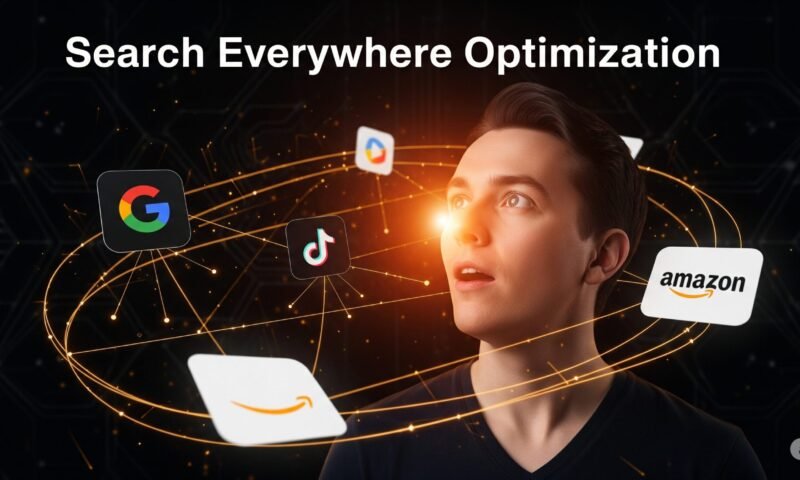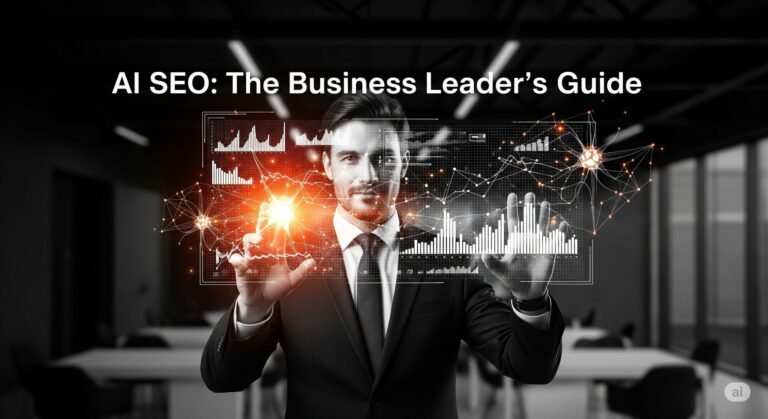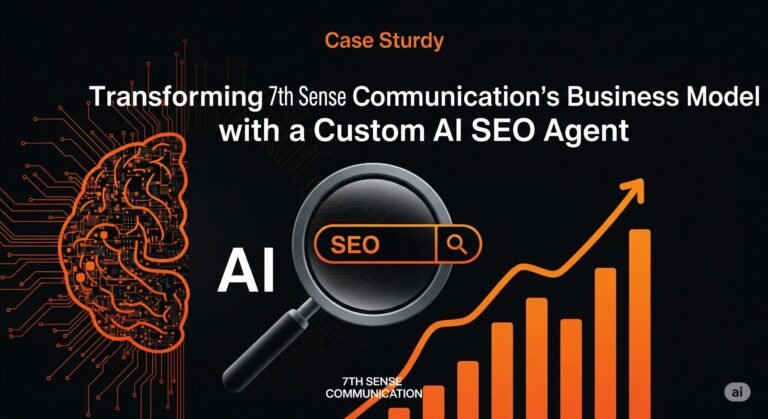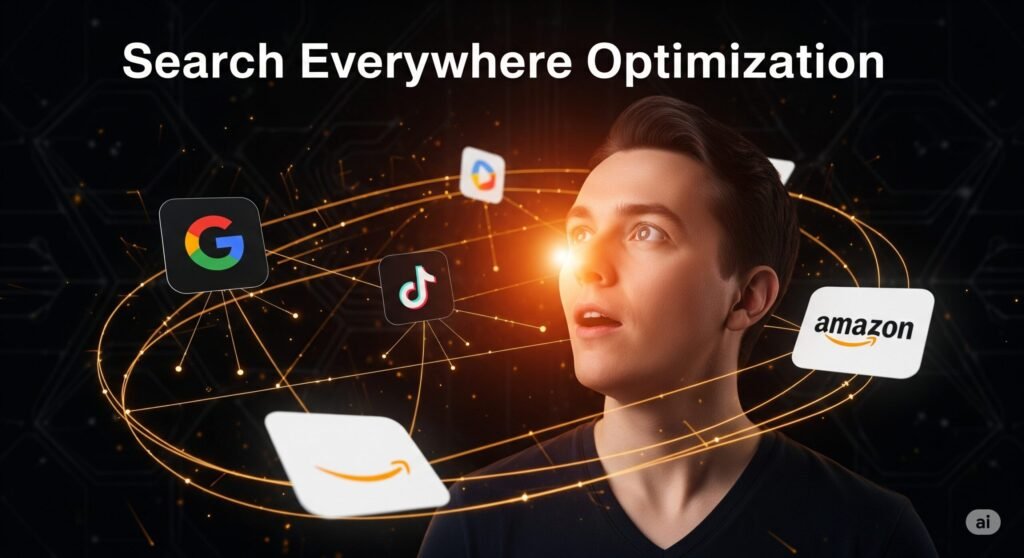
The New Search Reality: Why SEO Must Evolve
The Fracturing of Search Beyond Google
Remember the days when Google was the undisputed king of search? When a simple query would yield a page of blue links, and SEO was all about climbing those rankings? Those days aren’t just behind us—they’re practically ancient history in digital years.
Today’s search landscape has exploded into a complex ecosystem where users seek answers, discover products, and make decisions across dozens of platforms. Your potential customer might start their journey on TikTok watching a product review, jump to Amazon to check prices, ask ChatGPT for comparisons, read Reddit discussions, and finally land on your website through Google. Each of these touchpoints represents a critical moment of discovery—and a missed opportunity if you’re not there.
This fragmentation isn’t just a trend; it’s a fundamental rewiring of how humans find information. And for businesses, it represents both a seismic challenge and an unprecedented opportunity. The brands that thrive in this new landscape won’t be those clinging to traditional SEO alone—they’ll be the ones mastering what we now call SEO 2.0: the art and science of being discoverable everywhere your customers are searching.
Key Statistics Driving the Search Everywhere Optimization (SEO 2.0) Revolution
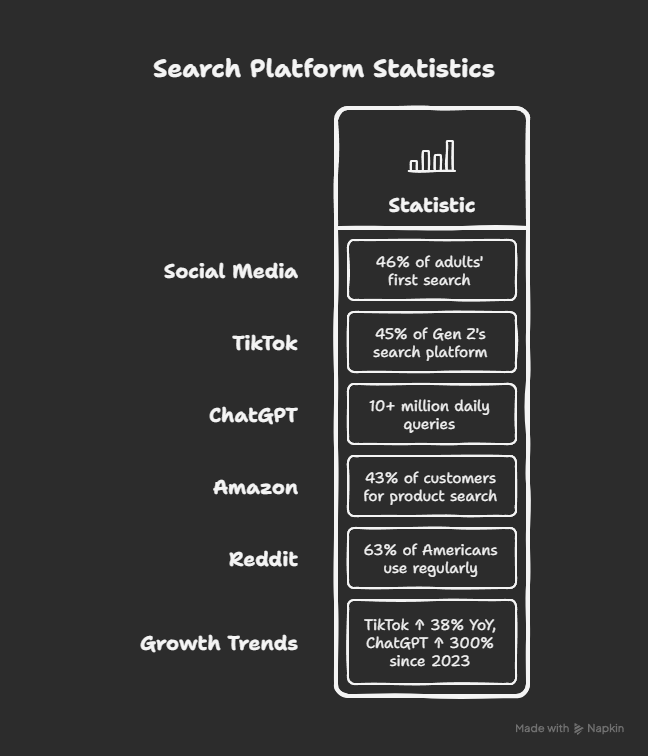
The numbers behind this shift are nothing short of staggering. Let’s look at the data that’s forcing every smart marketer to rethink their approach:
| Platform | Usage Statistic | Growth Trend |
| Social Media | 46% of adults use social media as their first platform for online search | ↑ 23% year-over-year |
| TikTok | 45% of Gen Zers use TikTok instead of Google for searches | ↑ 38% year-over-year |
| ChatGPT | 10+ million daily queries | ↑ 300% since 2023 |
| Amazon | 43% of customers go to the search bar when visiting an e-commerce platform | ↑ 15% year-over-year |
| 63% of Americans use Reddit’s search engine regularly | ↑ 28% year-over-year | |
| YouTube | 3+ billion searches per month (second-largest search engine) | ↑ 18% year-over-year |
Additional compelling statistics include that by 2028, AI-powered search volumes are projected to overtake traditional search engines, 24% of consumers now use social media as their primary source for finding information, 93.7% of voice search queries are answered without users ever visiting a website, and more than 100 people add “reddit” to Google searches every second.
These aren’t just interesting data points—they’re flashing neon signs pointing to the future of search. Every statistic represents millions of potential customer interactions happening outside traditional search engines.
What Happens When Brands Ignore Multi-Platform Search
Brands that cling to traditional SEO alone are increasingly invisible to large segments of their audience. The cost of this invisibility isn’t just theoretical—it’s measured in lost revenue, missed connections, and declining market relevance.
When you limit your optimization efforts to Google and Bing, you’re missing out on the growing number of users who start their product searches on Amazon, the millions of queries being answered by AI tools like ChatGPT and Perplexity, the visual discovery happening on platforms like Pinterest and Instagram, the video-based searches on YouTube and TikTok, the community-driven answers on forums like Reddit and Quora, and the conversational queries handled by voice assistants.
This invisibility comes at a steep cost: reduced brand awareness, lost traffic, fewer conversions, and ultimately, lower revenue. In today’s competitive digital landscape, being absent from key search platforms isn’t just a missed opportunity—it’s a business risk.
Get Your Free AI SEO Agent
Transform your website’s performance with our powerful SEO AI agents. Complete setup guide included – no technical expertise required.
Understanding SEO 2.0: The New Frontier of Search Optimization
Defining SEO 2.0: Beyond Traditional Search
Search Everywhere Optimization, or SEO 2.0, represents the evolution of search engine optimization for our fragmented digital landscape. While traditional SEO focuses on optimizing content for search engines like Google and Bing, SEO 2.0 expands this approach to include every platform where users search for information.
SEO 2.0 is the practice of optimizing your digital presence across all search environments—not just traditional search engines, but also social media platforms, AI tools, e-commerce marketplaces, video platforms, voice assistants, and online communities. It’s about ensuring your brand is discoverable wherever your audience is looking for answers, products, or services.
Think of SEO 2.0 as the next generation of search optimization—one that acknowledges and adapts to the reality that search happens everywhere, not just on Google. It’s not about replacing traditional SEO; it’s about expanding it to match modern user behavior.
The Core Components of Successful SEO 2.0
A comprehensive SEO 2.0 strategy consists of several key components. First, platform-specific optimization is essential since each platform has its own algorithms, content formats, and user behaviors. Effective SEO 2.0 requires understanding and optimizing for these unique characteristics.
Cross-platform consistency is equally important. While optimization tactics may vary by platform, your brand messaging and value proposition should remain consistent across all channels. Content adaptation is another critical component—the same core content often needs to be adapted for different platforms, transformed from a blog post to a video script, a social media thread, or an FAQ section.
Integrated analytics is necessary for measuring success across multiple platforms, requiring a unified approach that tracks performance holistically, not just in silos. Finally, strategic prioritization is crucial—with limited resources, businesses must prioritize which platforms to focus on based on their audience, industry, and goals.
How Search Everywhere Optimization (SEO 2.0) Differs from Omnichannel Marketing
While SEO 2.0 and omnichannel marketing share some similarities, they’re fundamentally different concepts. Omnichannel marketing focuses on creating seamless customer experiences across all touchpoints, with the primary goal of driving conversions and sales through consistent messaging. Its scope includes both organic and paid strategies across all marketing channels, and typical tactics include email campaigns, retargeting ads, and in-store experiences.
SEO 2.0, on the other hand, specifically focuses on optimizing for search behavior across platforms, with the main goal of maximizing visibility and discoverability. It’s concerned with organic search optimization across multiple platforms, using tactics like keyword optimization, content structuring, and platform-specific SEO. Success metrics for SEO 2.0 include search visibility, organic traffic, brand mentions, and AI citations across platforms.
In practice, SEO 2.0 should be part of a broader omnichannel marketing strategy, ensuring that your brand is not only present across multiple channels but also optimized for search within each one.
Traditional SEO vs. SEO 2.0: A Comprehensive Comparison
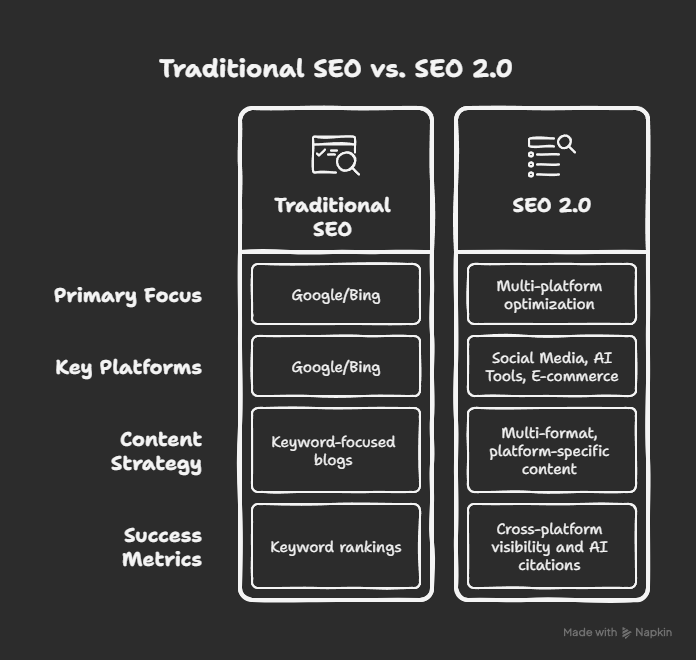
The evolution from traditional SEO to SEO 2.0 represents one of the most significant shifts in digital marketing history. Let’s examine how these approaches compare across key dimensions:
| Dimension | Traditional SEO | SEO 2.0 |
| Primary Focus | Optimizing for Google and Bing search algorithms | Optimizing for search behavior across all platforms |
| Key Platforms | Google, Bing | Google, Bing, Social Media, AI Tools, E-commerce Sites, Video Platforms, Voice Assistants, Forums |
| Content Strategy | Keyword-focused blog posts and web pages | Multi-format content adapted for each platform (text, video, audio, visual) |
| Success Metrics | Keyword rankings, organic traffic, backlinks | Platform-specific visibility, cross-platform traffic, brand mentions, AI citations |
| Technical Requirements | On-page SEO, technical SEO, backlink building | Platform-specific optimization, cross-platform content adaptation, AI-friendly structuring |
| User Journey | Focuses on search intent at the moment of query | Captures users throughout their entire discovery journey |
| Resource Needs | Specialized SEO skills and tools | Diverse skill sets including social media, video production, AI optimization |
| Risk Profile | Vulnerable to single-platform algorithm changes | Diversified presence reduces algorithmic risk |
| Time Horizon | Medium to long-term results | Both immediate (social) and long-term (traditional) results |
| Competitive Landscape | Well-established with clear best practices | Emerging and rapidly evolving with new opportunities |
The Evolution of Search Behavior
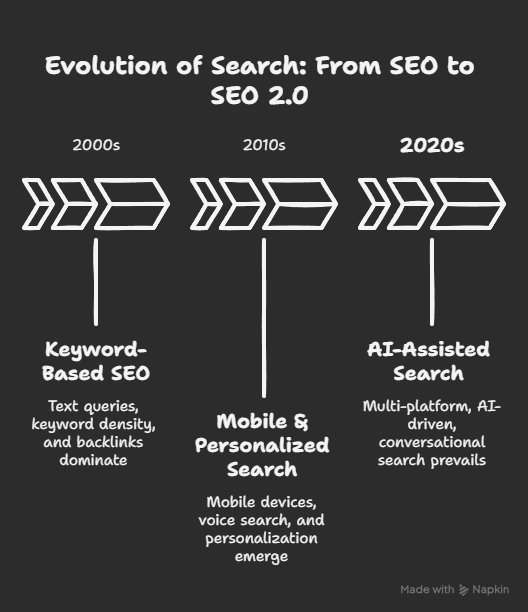
To truly understand why SEO 2.0 is necessary, let’s look at how search behavior has evolved over time. In the early 2000s, search was dominated by text-based queries on desktop computers, with platforms like Google, Yahoo, and MSN leading the way. SEO focused on keyword density, meta tags, and backlinks.
From the mid-2000s to 2010s, we saw more complex queries and the rise of mobile search. Platforms expanded to include Google, Bing, and YouTube, with SEO shifting toward content quality, user experience, and mobile optimization.
Between 2010 and 2020, voice search, visual search, and personalization became prominent. Google, YouTube, Amazon, and Pinterest were key platforms, with SEO emphasizing semantic search, featured snippets, and local SEO.
From 2020 to the present, we’ve entered the era of multi-platform, AI-assisted, conversational search across virtually all digital platforms. This has given rise to SEO 2.0, which focuses on cross-platform optimization and AI-friendly content.
This evolution shows that search isn’t changing—it’s fundamentally transforming into something entirely different. The brands that recognize this shift and adapt their strategies accordingly will be the ones that thrive in the coming years.
The Modern Search Ecosystem: Where Your Customers Are Looking
Traditional Search Engines (Google, Bing)
Despite the rise of alternative search platforms, traditional search engines remain crucial components of the search ecosystem. Google continues to dominate with a 91% market share, while Bing holds second place with 3.4%—a small share that still represents millions of searches daily.
However, even traditional search has evolved dramatically. Today’s search results pages feature AI overviews, featured snippets, video carousels, image packs, “People Also Ask” sections, local results, and shopping listings. Optimizing for these enhanced SERP features requires a more sophisticated approach than traditional SEO. You need to create content that can be easily extracted and featured in these various formats, which means structuring your content with clear headings, bullet points, and concise answers to common questions.
Social Media Platforms (Instagram, TikTok, LinkedIn, Pinterest)
Social media platforms have evolved from purely social networks into powerful search engines in their own right. Nearly 40% of young people turn to social media platforms like TikTok and Instagram to find answers, making social search an essential component of any SEO 2.0 strategy.
Each platform has its own search characteristics. Instagram and Facebook are essential for brand discovery and user engagement, with optimization involving keywords, hashtags, and location tags. TikTok has become an incredible discovery engine, with users flooding Google with search phrases coined in the app. LinkedIn is where B2B decision-makers search for industry insights, while Pinterest is an incredibly powerful visual search engine ideal for lifestyle, fashion, and retail brands.
AI-Powered Search (ChatGPT, Gemini, Perplexity)
AI-powered search tools like ChatGPT, Gemini, and Perplexity are rapidly gaining ground as primary research tools for millions of users daily. These platforms don’t always send direct traffic to websites, but they’re fantastic at raising brand awareness and establishing authority.
The growth of AI search has been explosive, with ChatGPT reaching 100+ million monthly active users since its launch in November 2022. Other platforms like Gemini, Perplexity, and Claude are also seeing significant growth. Optimizing for AI search, also known as Generative Engine Optimization (GEO) or Large Language Model (LLM) optimization, focuses on increasing the chances that chatbot platforms will mention your brand when providing answers to user queries.
Get Your Free AI SEO Agent
Transform your website’s performance with our powerful SEO AI agents. Complete setup guide included – no technical expertise required.
Video Search (YouTube, TikTok)
Video search represents one of the fastest-growing segments of the search ecosystem. YouTube is the second most popular search engine globally with 3+ billion searches per month, and TikTok has emerged as a powerful video search platform, particularly among younger demographics. YouTube users spend an average of 40 minutes per session, while TikTok users spend even longer at 52 minutes.
Optimizing for video search involves creating content that’s both discoverable and engaging, with attention to titles, descriptions, thumbnails, and content structure. The most successful video content on these platforms includes how-to guides, entertainment, product reviews, and trend-based content.
E-commerce Platforms (Amazon, Etsy)
Online stores have become search engines in their own right, especially for product discovery. Amazon is particularly dominant in this space, with 43% of customers going to the search bar when they visit an e-commerce shopping platform. Amazon sees 2+ billion searches monthly, with conversion rates between 15-20%—significantly higher than most websites.
Other important e-commerce search platforms include eBay, Etsy, and Walmart, each with their own user bases and optimization requirements. Optimizing for e-commerce platforms involves product listing optimization, customer reviews, and platform-specific advertising strategies.
Emerging Channels (Voice Search, Forums, Podcasts)
Several emerging channels are becoming increasingly important for search visibility. Voice search is growing at 35% annually with 4+ billion users worldwide. Forums like Reddit and Quora are growing at 25% annually with 500+ million users. Podcasts are growing at 20% annually with 400+ million listeners, while AR/VR search is growing at an explosive 50% annually.
These emerging channels represent the frontier of search optimization, offering early adopters a significant advantage as these platforms continue to grow. Each requires specific optimization strategies, from conversational keywords for voice search to community engagement for forums and keyword-rich titles for podcasts.
The Strategic SEO 2.0 Implementation Framework
Phase 1: Audit & Assessment
Mapping Your Current Multi-Platform Presence
Before you can optimize your presence across multiple platforms, you need to understand where you currently stand. This involves conducting a comprehensive audit of your existing digital footprint across all relevant search platforms.
Start by creating an inventory of all the platforms where your brand currently has a presence. This should include traditional search (your website’s current SEO performance), social media profiles (all active and inactive accounts), video platforms (YouTube, TikTok, etc.), e-commerce marketplaces (if you sell products), AI search visibility (are you being mentioned by ChatGPT or other AI tools?), forum participation (Reddit, Quora, industry-specific forums), and podcast presence (as a guest or host).
For each platform, document your current level of activity, follower counts, engagement rates, and any existing optimization efforts. This will give you a baseline against which to measure future progress.
Analyzing Your Audience’s Search Behavior
Understanding where your audience searches for information is crucial for effective SEO 2.0. This involves going beyond basic demographics to understand search behaviors and preferences across different platforms.
Use a combination of quantitative and qualitative research methods. Review your website analytics to see where your traffic is coming from. Ask your customers directly which platforms they use to search for information related to your products or services. Use social listening tools to monitor conversations about your brand, products, and industry across different platforms. Conduct keyword research across different platforms to understand what your audience is searching for and where.
The goal is to build a comprehensive picture of your audience’s search journey, from initial awareness to final purchase decision.
Identifying Your Highest-Impact Platforms
Not all platforms will be equally important for your business. Based on your audit and audience research, identify the platforms that offer the highest potential impact for your specific goals.
Consider factors such as audience presence (where does your target audience spend the most time?), search intent (which platforms do they use for different types of searches?), competitive landscape (where are your competitors most active, and where are there gaps you can fill?), resource requirements (what level of resources would be required to compete effectively on each platform?), and potential ROI (which platforms offer the best potential return on your investment?).
Prioritize platforms based on a combination of audience importance, competitive opportunity, and resource requirements. This will help you focus your efforts where they’ll have the greatest impact.
Phase 2: Strategic Prioritization
The SEO 2.0 Priority Matrix: Where to Focus First
With limited resources, you can’t optimize for every platform at once. The SEO 2.0 Priority Matrix helps you determine where to focus your efforts based on two key dimensions:
| Platform Category | High Impact | Low Impact |
| Low Effort | Quick Wins• Google Business Profile• Social profiles• FAQ content for AI | Fill-Ins• Pinterest optimization• Basic forum presence• Occasional content |
| High Effort | Major Projects• YouTube content• Podcast production• Comprehensive AI opt | Time Sinks• Niche forums• Emerging AR/VR• Experimental platforms |
This matrix provides a visual framework for prioritizing your SEO 2.0 efforts and allocating resources effectively. Focus first on the “Quick Wins” quadrant—platforms that offer high impact with relatively low effort. These might include optimizing your Google Business Profile, completing your social media profiles, and creating FAQ content optimized for AI search.
Industry-Specific Platform Priorities
Different industries will have different platform priorities based on where their target audiences search for information. For e-commerce businesses, Amazon, Instagram, Pinterest, Google Shopping, YouTube, and TikTok are typically top priority platforms, with AR try-on experiences and live shopping representing emerging opportunities.
B2B services should focus on LinkedIn, Google, industry forums, YouTube, email newsletters, and webinars, with AI-powered research tools and professional communities as emerging opportunities. Local businesses should prioritize Google Maps, Facebook, Yelp, Nextdoor, Instagram, and community forums, with voice search and AR local discovery as emerging frontiers.
Content publishers should focus on Google, YouTube, Medium, LinkedIn, newsletters, and podcast platforms, with AI content platforms and interactive content representing new opportunities. SaaS companies should prioritize Google, LinkedIn, review sites, YouTube, industry forums, and webinars, with AI tool integrations and community platforms as emerging channels.
These are general guidelines, and your specific priorities should be based on your audience research and business goals.
Resource Allocation Strategies for Different Budget Levels
Your SEO 2.0 strategy will need to be tailored to your available resources. For limited budgets (under $1k/month), focus on 1-2 high-impact, low-effort platforms. Concentrate on organic tactics, content repurposing, and community building. Expect significant results within 6-12 months.
With moderate budgets ($1k-$5k/month), you can expand to 3-4 platforms across categories. Implement a mix of organic and paid tactics, some outsourcing, and tool investment. You can expect significant results within 3-6 months.
For substantial budgets ($5k+/month), implement a comprehensive multi-platform strategy with a full team or agency partnership, premium tools, and continuous optimization. You can expect initial results within 1-3 months.
Regardless of your budget level, the key is to prioritize strategically and focus your resources where they’ll have the greatest impact.
Phase 3: Platform-Specific Optimization
Traditional Search: Advanced SEO for 2025
While traditional SEO remains a cornerstone of SEO 2.0, it has evolved significantly. Today’s approach emphasizes semantic search, topic clusters, and natural language over exact match keywords and keyword density. Content has expanded from blog posts and product pages to include multi-format content, interactive elements, and AI-friendly structure.
Technical elements have evolved from meta tags and header tags to include schema markup, Core Web Vitals, and mobile-first indexing. Authority building now focuses on E-E-A-T signals and brand mentions across platforms, not just backlinks and domain authority. User experience has expanded from page speed and navigation to include personalization, interactive elements, and accessibility.
The key to success in traditional search is demonstrating E-E-A-T (Experience, Expertise, Authoritativeness, Trustworthiness) through your content. The more you can establish your authority on a topic, the better your chances of ranking well and being featured in prominent SERP positions.
Social Search: Profile & Content Optimization
Each social platform has its own optimization requirements, but some general principles apply across platforms. Profile optimization should include consistent branding, keyword-rich bios, and complete information. For Instagram, focus on a strong link in bio strategy. For TikTok, maintain a clear niche focus. For LinkedIn, develop a detailed experience section.
Content optimization should include platform-specific formats, relevant keywords, and engaging visuals. Instagram requires high-quality images and Reels, while TikTok demands trend participation and authentic content. LinkedIn is best for professional insights and long-form posts.
Engagement is crucial across all platforms—respond to comments, ask questions, and participate in conversations. Hashtags and keywords should be researched and implemented strategically, with Instagram using 10-15 targeted hashtags, LinkedIn using 3-5 professional hashtags, and TikTok focusing on both trending and niche hashtags.
Cross-promotion should be strategic, with content shared appropriately across platforms. YouTube content can be promoted on other platforms, and blogs can embed social content to create a cohesive ecosystem.
AI Search: Generative Engine Optimization (GEO)
Optimizing for AI search requires a different approach than traditional SEO. Structured content with clear headings, logical sections, and FAQ formats has a higher chance of being cited in AI responses. Entity optimization—defining key entities, using schema markup, and maintaining consistency—helps AI systems better understand your content.
Authority building through expert contributions, high-quality backlinks, and brand mentions increases the likelihood of being recommended by AI. Natural language with a conversational tone, question-based content, and clear answers better aligns with how AI processes and generates text.
Comprehensive coverage that thoroughly addresses topics provides more opportunities for AI to extract relevant information. This approach increases your chances of being featured in AI-generated responses and establishing your brand as an authoritative source.
Video Search: YouTube & TikTok Strategies
Video optimization requires attention to both content and technical elements. For YouTube, use tools like TubeBuddy to identify keywords and include them in titles, descriptions, and tags. Create compelling titles with keywords and custom thumbnails. Include timestamps, chapters, and end screens to improve user experience and searchability.
For TikTok, focus on trending sounds, hashtags, and challenges. Create eye-catching thumbnails and trend-focused titles. Structure content with a hook in the first 3 seconds, follow trending formats, and include clear calls to action.
Engagement is crucial on both platforms. For YouTube, encourage likes, comments, and subscriptions. For TikTok, prompt duets, stitches, shares, and saves. Maintain consistency with regular upload schedules and consistent branding, though the specific approach will differ between platforms—YouTube benefits from a regular upload schedule, while TikTok requires daily posting and trend participation.
E-commerce: Product Listing Optimization
For e-commerce platforms, product listing optimization is crucial. Product titles should include primary keywords first and key benefits, with Amazon limiting titles to under 200 characters and eBay recommending inclusion of condition, brand, and model.
Product images should be high-resolution with multiple angles and lifestyle shots. Amazon requires a white background for the main image, while eBay benefits from showing products in use. Descriptions should be detailed with specifications, bullet points, and FAQ sections, including dimensions, materials, and care instructions.
Reviews are essential—encourage them and respond professionally. Amazon suggests following up with buyers, while eBay may offer incentives for reviews. Pricing strategy should include competitive pricing and bundle offers, with Amazon benefiting from automated pricing tools and eBay offering choices between auction and Buy It Now formats.
Phase 4: Cross-Platform Integration
Creating a Unified Content Strategy
A unified content strategy ensures consistency across platforms while allowing for platform-specific adaptations. Start by identifying 3-5 core topics (content pillars) aligned with your brand and audience through keyword research, audience surveys, and competitor analysis.
Map these pillars to appropriate platforms based on format and audience preferences, using content calendar tools and platform analytics. Schedule content across all platforms with consistent messaging using tools like Trello, Asana, CoSchedule, or Hootsuite.
Implement systematic content repurposing to adapt content for multiple platforms. Use Canva for visuals, Loom for video, and Otter.ai for transcription. Monitor performance across platforms and adjust strategy using Google Analytics, platform-native analytics, and unified dashboards.
Maintaining Brand Consistency Across Platforms
While adapting content for different platforms, maintain brand consistency in visual identity, brand voice, core messaging, customer experience, and quality standards. Implement a style guide with colors, fonts, and logo usage for visual identity, and conduct regular brand audits to ensure visual consistency.
Develop voice and tone guidelines with examples for different contexts to maintain brand voice, and conduct content reviews and sentiment analysis. Integrate key value propositions and mission statements into core messaging, and conduct content audits with message consistency scoring.
Set service standards and response time expectations for customer experience, and monitor through customer feedback and satisfaction surveys. Establish content quality benchmarks and production values, implementing quality assurance processes and performance metrics.
Content Repurposing Frameworks
Efficient content repurposing is essential for managing a multi-platform presence. The content pyramid approach starts with long-form content like blog posts or whitepapers and transforms them into social posts, infographics, video scripts, and podcast episodes. Use Canva for visuals, Loom for video, and Otter.ai for transcription.
Format transformation converts content from one format to another—video to blog post, infographic to social media series, etc. Use tools like Descript for editing and Rev.com for transcription. Platform adaptation takes core messages and tailors them for specific platform presentations, using platform analytics and audience research.
Audience customization adapts general content for specific segments, such as industry-specific versions or beginner vs. expert content. Use audience segmentation and personalization tools to deliver the right content to the right audience.
Get Your Free AI SEO Agent
Transform your website’s performance with our powerful SEO AI agents. Complete setup guide included – no technical expertise required.
Measuring SEO 2.0 Success: The Multi-Platform Analytics Framework
Key Performance Indicators for Each Platform
To measure the success of your SEO 2.0 strategy, you need to track relevant KPIs for each platform. For traditional search, monitor organic traffic, keyword rankings, click-through rates, bounce rates, conversion rates, and featured snippet appearances using Google Analytics, Search Console, and SEMrush.
Social media metrics should include engagement rate, follower growth, reach, share of voice, sentiment, and referral traffic, tracked through platform analytics, Sprout Social, and Hootsuite. For AI search, track brand mentions, citation frequency, visibility scores, traffic from AI tools, and authority metrics using Brand24, Mention, and manual monitoring.
Video platform metrics include views, watch time, subscriber growth, engagement rate, click-through rate, and conversion rate, measured through YouTube Analytics, TikTok Analytics, and VidIQ. E-commerce metrics should track product rankings, impressions, conversion rate, average order value, review ratings, and revenue using Amazon Seller Central and platform analytics.
For emerging channels, monitor forum engagement, voice search visibility, podcast downloads, community growth, sentiment, and referral traffic through platform-specific analytics and social listening tools.
Cross-Platform Measurement Tools & Techniques
Measuring performance across multiple platforms requires the right tools and techniques. Unified analytics tools like Google Analytics 4 and Adobe Analytics provide cross-platform tracking and attribution modeling for a holistic performance view.
Social media management tools like Hootsuite, Sprout Social, and Buffer offer multi-platform scheduling, analytics, and engagement tracking. AI monitoring tools such as Brand24, Mention, and Talkwalker help track brand mentions, sentiment analysis, and trend tracking.
SEO suites like SEMrush, Ahrefs, and Moz provide keyword tracking, competitor analysis, and site audits for traditional SEO performance. Custom dashboards built with Google Data Studio, Tableau, or Power BI enable custom visualizations and data integration for executive reporting and analysis.
Calculating ROI Across Multiple Channels
Calculating ROI for SEO 2.0 requires a comprehensive approach that accounts for both direct and indirect benefits. For direct revenue, use attribution modeling and conversion tracking through Google Analytics and CRM integration. The challenge of multi-touch attribution complexity can be addressed with data-driven attribution models.
For indirect value measurement, conduct brand lift studies and sentiment analysis through surveys and social listening. The difficulty of quantification can be overcome by establishing baseline metrics and tracking changes over time.
Cost analysis should include resource allocation tracking and tool costs through project management tools and financial software. Implement comprehensive time and resource tracking to capture hidden costs.
Customer lifetime value can be measured through cohort analysis and retention metrics using CRM data and predictive analytics. Use predictive LTV models to address the challenge of long measurement periods.
For comparative analysis, calculate platform-specific ROI using custom dashboards and spreadsheet models. Normalize different platform metrics to enable meaningful comparison across channels.
Reporting Frameworks for Stakeholders
Effective reporting is crucial for demonstrating the value of your SEO 2.0 strategy to stakeholders. For executive leadership, focus on business impact, ROI, and strategic insights with metrics like revenue, cost savings, market share, and brand metrics. Provide quarterly reports in the form of executive dashboards and summary reports.
For the marketing team, provide detailed reports with performance trends and optimization opportunities, including platform-specific metrics, content performance, and engagement metrics. These should be delivered monthly with detailed analysis and recommendations.
The sales team needs sales-focused dashboards and lead quality reports with metrics like lead volume, lead quality, conversion rates, and deal size, delivered bi-weekly. For the content team, provide weekly content performance reports and audience insights with metrics like content performance, audience growth, and engagement rates.
The finance department requires financial reports and budget vs. actual analysis with metrics like spend vs. budget, cost per acquisition, and ROI by channel, delivered monthly.
Overcoming Common SEO 2.0 Challenges
Limited Resources: Doing More with Less
Resource constraints are one of the biggest challenges businesses face when implementing SEO 2.0. Strategic prioritization using an impact/effort matrix can help focus on 2-3 high-impact platforms first, leading to better results with focused effort.
Content repurposing frameworks allow you to create content once and adapt it for multiple platforms, yielding 3-5x more content from the same effort. Focusing on organic tactics and free tools can yield significant results without financial investment.
Automation and scheduling tools help with time constraints through batch content creation and scheduled posting, enabling consistent presence with less daily effort. For expertise gaps, focus on learning one platform at a time using platform resources and courses, gradually developing skills across platforms.
Algorithm Changes: Staying Agile Across Platforms
Algorithm changes are a constant challenge in digital marketing. Maintain a diversified platform presence to reduce vulnerability to any single platform’s algorithm changes. Set up alerts for industry news and monitor performance metrics to stay informed about platform algorithm updates.
Stay current with platform developments by following platform blogs and joining industry communities. When feature changes occur, adapt your content strategy to leverage new features. For policy changes, take a compliance-first approach with regular policy reviews and legal consultation.
Monitor competitors regularly and conduct market research to stay ahead of competitive shifts. If user behavior changes, conduct regular surveys, implement social listening, and review analytics to adapt your content strategy and experiment with new formats.
Team Structure: Breaking Down Organizational Silos
Organizational silos can hinder effective SEO 2.0 implementation. Form cross-functional teams with members from different departments and shared goals to break down departmental silos. Measure success through cross-department projects completed and shared KPI achievement.
Implement knowledge sharing systems with documentation, regular training sessions, and internal workshops to address knowledge silos. Track success through documentation completeness and skill development across the team.
Evaluate and implement integrated tools that work across functions to eliminate tool silos. Measure success through tool adoption rates and cross-functional data access. Create shared OKRs that span departments and conduct regular alignment meetings to address goal silos. Track success through shared goal achievement and interdepartmental collaboration frequency.
Implement structured communication with regular cross-functional meetings and shared communication channels to address communication silos. Measure success through meeting effectiveness and information flow across teams.
Content Creation at Scale: Efficiency Strategies
Creating content for multiple platforms at scale is a significant challenge. Identify 3-5 core topics and create content clusters using keyword research tools and content planning software, reducing planning time by 40-60%.
Develop templates for different content types using template libraries and style guides, speeding up content creation by 50-70%. Create content in batches by type or platform using content calendars and project management tools, increasing production efficiency by 30-50%.
Assign specific roles based on team members’ strengths through skills assessments and role definitions, improving content quality by 25-40%. Use AI tools for ideation, outlines, and drafts with AI writing tools and content generation platforms, reducing initial draft time by 60-80%.
Industry-Specific SEO 2.0 Strategies
E-commerce SEO 2.0: Maximizing Product Discovery
For e-commerce businesses, SEO 2.0 focuses on maximizing product discovery across multiple platforms. Amazon optimization should include keyword-rich listings, high-quality images, and reviews, potentially increasing marketplace sales by 150-300%.
Implement social commerce on Instagram, Pinterest, and TikTok with shoppable posts, product tags, and social proof, which can increase social-driven revenue by 40-80%. Optimize for visual search on Pinterest and Google Lens with descriptive alt text and file names to increase visual search traffic by 25-50%.
Encourage and professionally respond to reviews on platforms like Yelp and Google Reviews, improving conversion rates by 30-60%. Create comparison content on blogs, YouTube, and social media to increase informed purchase decisions by 50-100%.
B2B SEO 2.0: Leveraging Professional Platforms
B2B companies have unique SEO 2.0 opportunities on professional platforms. Optimize LinkedIn profiles and publish thought leadership content to increase B2B lead generation by 100-200%. Create whitepapers, case studies, and webinars to establish thought leadership, improving brand authority by 150-300%.
Provide valuable insights and answer questions authentically on industry forums like Reddit and Quora to increase qualified referrals by 50-100%. Create educational content and product demonstrations for YouTube and LinkedIn Video to increase engagement rates by 75-150%.
Repurpose content for email nurturing sequences to improve lead-to-customer conversion by 30-60%. This multi-platform approach establishes authority and captures potential customers throughout their research journey.
Local Business SEO 2.0: Dominating Geographic Search
Local businesses need to focus on geographic search across multiple platforms. Complete your Google Business Profile with photos and encourage reviews to increase local discovery by 50-100%. Ensure consistent NAP (Name, Address, Phone) information across local directories like Yelp and Yellow Pages to improve local rankings by 25-50%.
Use location tags and geotargeting on Facebook and Instagram to increase local engagement by 40-80%. Participate in local discussions and sponsor events on platforms like Nextdoor and Facebook Groups to increase community trust by 30-60%.
Cover local topics, events, and community interests in your blog and social media content to increase local relevance by 50-100%. This localized approach helps businesses dominate their geographic market across multiple search platforms.
Content Publishers: Multi-Platform Distribution
Content publishers need to focus on maximizing reach and engagement across multiple platforms. Repurpose content with proper attribution and links on platforms like Medium and LinkedIn to increase content reach by 100-200%.
Convert articles to video summaries and tutorials for YouTube, TikTok, and Instagram Reels to increase video engagement by 150-300%. Convert written content to audio format for podcast platforms to increase audience accessibility by 50-100%.
Use multi-platform content to build email lists through newsletters on platforms like Substack and Medium to improve audience retention by 30-60%. Create communities around content topics on platforms like Discord, Slack, and Facebook Groups to increase audience loyalty by 100-200%.
Real-World SEO 2.0 Success Stories
Case Study 1: E-commerce Brand’s 300% Traffic Increase
A mid-sized e-commerce brand selling home goods implemented a comprehensive SEO 2.0 strategy that resulted in a 300% increase in organic traffic across all platforms. The brand was heavily dependent on Google for traffic and sales, making them vulnerable to algorithm changes and limiting their growth potential.
They implemented a multi-platform SEO 2.0 strategy with four key components: completely revamping their Amazon listings with keyword-rich titles, enhanced images, and A+ content; developing a Pinterest strategy focused on home inspiration and DIY projects; creating a YouTube channel with home improvement tutorials and product demonstrations; and implementing Instagram Shopping features for direct purchasing.
The results were impressive. Within the first two months, they saw a 40% increase in total traffic, with Amazon traffic growing from 5,000 to 7,500 visits monthly, Pinterest traffic increasing from 2,000 to 3,500 visits, and YouTube traffic doubling from 1,000 to 2,000 visits. By months 3-4, total traffic had increased by 120%, and by months 5-6, they achieved a 300% increase in overall organic traffic, with Amazon and Pinterest each driving more traffic than Google had previously. Their diversified presence also made them more resilient to algorithm changes.
Case Study 2: B2B Company’s Lead Generation Transformation
A B2B software company transformed their lead generation through a strategic SEO 2.0 approach focused on professional platforms. The company was struggling to generate qualified leads through traditional SEO and wanted to expand their reach beyond Google.
They implemented a B2B-focused SEO 2.0 strategy with four key elements: optimizing their company page and encouraging employees to optimize their personal profiles on LinkedIn; creating in-depth whitepapers and case studies addressing industry pain points; launching a webinar series featuring industry experts; and actively participating in industry-specific forums and communities.
The results were transformative. Within a year, the company saw a 200% increase in qualified leads, with LinkedIn becoming their primary source of high-quality leads. Google organic leads increased by 50% with a 20% improvement in lead quality. LinkedIn leads grew from 10 to 120 monthly—a 1100% increase—with 40% better lead quality. Webinars generated 60 new high-quality leads per month, and industry forum leads grew from 5 to 45 monthly—an 800% increase with 35% better lead quality. Overall, their thought leadership content significantly improved their brand authority and credibility in the industry.
Get Your Free AI SEO Agent
Transform your website’s performance with our powerful SEO AI agents. Complete setup guide included – no technical expertise required.
Case Study 3: Local Business’s Multi-Platform Domination
A local restaurant chain achieved multi-platform domination in their market through a comprehensive local SEO 2.0 strategy. The restaurant chain wanted to increase visibility and attract more customers across multiple locations in a competitive market.
They implemented a local-focused SEO 2.0 strategy with four components: completely optimizing their Google Business Profiles for all locations; developing location-specific social media profiles on Facebook and Instagram; engaging with local communities on platforms like Nextdoor and Facebook Groups; and partnering with local food influencers to create content across multiple platforms.
Within six months, the restaurant chain saw a 75% increase in foot traffic across all locations. Their downtown location increased from 150 to 265 daily customers (77% increase), suburban north from 120 to 210 customers (75% increase), and suburban south from 100 to 175 customers (75% increase). This translated to approximately 80% revenue growth across all locations. They also achieved top rankings in local search results on Google and saw significant increases in engagement on social media platforms.
The Future of Search Everywhere Optimization
Emerging Platforms to Watch
The search landscape continues to evolve, with several emerging platforms gaining traction. Augmented Reality Search is in early adoption but growing at 50% annually, offering opportunities for visual product discovery and local exploration. Virtual Reality Environments are still niche but growing at 40% annually, with potential for virtual showrooms and immersive experiences.
Niche Social Platforms are fragmented but active, growing at 25% annually and offering opportunities for community building and targeted engagement. Blockchain-Based Search is experimental but growing at 100%+ annually, focusing on privacy-focused search and decentralized content. Enterprise Search Tools are growing rapidly at 35% annually, providing opportunities for B2B content discovery and internal knowledge sharing.
AI’s Evolving Role in Search
AI continues to transform search in several key ways. Multimodal Search currently has moderate impact but is expected to be high by 2026, requiring optimization for text, image, video, and audio simultaneously. Predictive Search is emerging but expected to be widespread by 2025, requiring brands to anticipate user needs and create proactive content.
Personalization already has significant impact and is expected to be nearly universal by 2026, requiring a balance between personalization and broad discoverability. Conversational Search is growing rapidly and expected to be dominant by 2025, requiring dialogue-friendly content and FAQ optimization. Automated Content Creation is emerging but expected to have significant impact by 2026, requiring a focus on human expertise, unique insights, and authenticity.
Preparing Your Strategy for What’s Next
To prepare for the future of search, consider these strategic approaches. Create a flexible framework with adaptable strategy templates and regular review cycles to pivot quickly as search evolves. Implement continuous learning through training programs, industry conference attendance, and experimentation budgets to stay ahead of trends and algorithm changes.
Allocate resources for testing new platforms and join beta programs to gain first-mover advantage on emerging platforms. Implement comprehensive analytics and regular performance reviews to make data-driven decisions and optimize based on real performance data. Maintain a customer-centric focus with regular customer research, feedback loops, and user testing to maintain relevance regardless of platform changes.
Getting Started with Your SEO 2.0 Strategy
30-Day SEO 2.0 Kickstart Plan
Ready to implement SEO 2.0 but not sure where to start? This 30-day kickstart plan will help you get going. In Week 1, focus on assessment and planning: conduct a platform audit on days 1-3, perform audience research on days 4-5, and create a prioritization matrix on days 6-7. The goal is to complete your audit and identify your top 2-3 platforms.
In Week 2, build your foundation by optimizing profiles on days 8-10, creating a content calendar on days 11-12, and setting up analytics on days 13-14. The goal is to have optimized profiles and a 30-day content plan.
Week 3 focuses on content creation: create core content on days 15-18 and adapt it for specific platforms on days 19-21. Aim to produce 4-6 pieces of platform-optimized content.
In Week 4, focus on engagement and analysis: engage with communities on days 22-24, review performance on days 25-27, and refine your strategy on days 28-30. The goal is to establish initial engagement metrics and develop a refined strategy moving forward.
Essential Tools for SEO 2.0 Implementation
Having the right tools can significantly improve your SEO 2.0 effectiveness. For keyword research, consider Ubersuggest (free), SEMrush ($100-$500/month), or Ahrefs ($100-$500/month), which offer keyword discovery, competition analysis, and search volume data.
For content creation, Canva (free-$60/month), Adobe Creative Suite ($50-$600/month), and Loom (free-$30/month) provide design, video creation, and screen recording capabilities. Social media management tools like Hootsuite (free-$500/month), Buffer (free-$100/month), and Sprout Social ($100-$500/month) offer scheduling, analytics, and engagement management.
Analytics tools include Google Analytics (free), platform-native tools (free-$300/month), and AI monitoring tools like Brand24 ($50-$500/month), Mention ($50-$500/month), and Talkwalker ($100-$500/month) for brand mentions, sentiment analysis, and trend tracking. Project management tools like Asana (free-$300/month), Trello (free-$300/month), and Monday.com (free-$300/month) help with task management, team collaboration, and workflow automation.
Common Mistakes to Avoid
As you implement your SEO 2.0 strategy, be careful to avoid common mistakes. Spreading too thin across too many platforms leads to mediocre results everywhere and resource burnout. Focus on 2-3 priority platforms first, and if needed, consolidate efforts and pause low-performing platforms.
Inconsistent branding confuses your audience and dilutes your brand identity. Create brand guidelines and review all content to ensure consistency. If you notice inconsistencies, audit and update all profiles for consistency.
Ignoring platform differences results in poor performance and low engagement. Research each platform’s best practices and adapt content accordingly. Study successful competitors and adapt your content to match platform norms.
Neglecting analytics means you have no way to measure success or optimize. Set up tracking before starting and establish baseline metrics. If you haven’t been tracking, implement analytics and establish baseline metrics.
Having a short-term focus leads to abandoning strategies before they have time to work. Set realistic timelines and be patient. If you’re tempted to make changes too quickly, review long-term trends and avoid knee-jerk reactions.
Conclusion: Embracing the Search Everywhere Revolution
Key Takeaways for Immediate Implementation
As we wrap up this comprehensive guide to SEO 2.0, let’s recap the key takeaways you can implement immediately. The search landscape has fundamentally transformed, with users now searching for information across social media, AI tools, e-commerce platforms, and more. Your optimization strategy must reflect this new reality.
SEO 2.0 requires both platform-specific tactics and cross-platform consistency. While optimization approaches vary by platform, your brand messaging and value proposition should remain consistent. Strategic prioritization is essential—with limited resources, focus on the platforms that offer the highest potential impact for your specific business and audience.
Measurement must be comprehensive. Track performance across all platforms using appropriate metrics and tools, and calculate ROI for your SEO 2.0 efforts. The future of search will continue to evolve, so stay flexible, keep learning, and be prepared to adapt your strategy as new technologies and platforms emerge.
The Long-Term Vision for SEO 2.0 Success
Looking ahead, the long-term vision for SEO 2.0 success involves creating a comprehensive, integrated digital presence that meets your audience wherever they search for information. This means building authority and trust across multiple platforms, creating valuable, platform-specific content that addresses user needs, continuously adapting to new technologies and changing user behaviors, measuring and optimizing performance across all platforms, and integrating SEO 2.0 into your broader marketing and business strategies.
By embracing this vision and implementing the strategies outlined in this guide, you can position your brand for success in the new era of search everywhere optimization. The future of search is multi-platform, and the time to adapt is now.
The brands that thrive in the coming years won’t be those clinging to the past—they’ll be the ones boldly stepping into the future of SEO 2.0, ready to meet their customers wherever they search, whenever they search, and however they search.
Get Your Free AI SEO Agent
Transform your website’s performance with our powerful SEO AI agents. Complete setup guide included – no technical expertise required.
